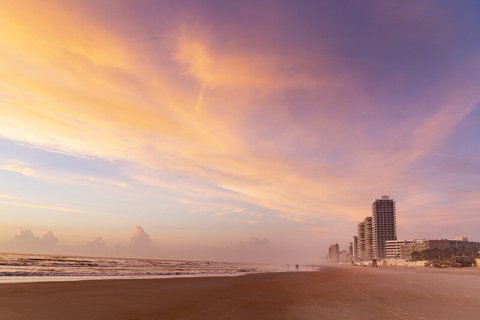
In November 2022, several successive hurricanes wreaked havoc on the Florida coast, when some houses and even swimming pools were left hanging over the ocean, as waves washed out the ground under them. Dozens of single- and multi-family houses in Daytona Beach were deemed unsafe.
This destruction raised many concerns, as people questioned what percentage of real estate situated on the remaining Florida coast is under threat of collapsing and whether it can be saved.
Experts studying climate change forecast that the sea level at the US East Coast will rise by an average of 25 – 35 cm over the next 30 years and by 35 – 45 cm on the coast of the Gulf of Mexico as the planet heats up. Higher temperature also increases the intensity of hurricanes.
With a higher sea level and stronger storm surges, ocean waves can easier wash out beaches and soak cement foundations in aggressive sea water. This, along with land subsidence, makes living in a coast area riskier.
The risk of erosion varies depending on the soil, geology, and natural changes of the coastline. This risk is extremely common in US coastal areas, especially in Florida. Ageing or dilapidated buildings, as well as outdated construction methods and low-quality materials can exacerbate the risk drastically.
So what can be done to mitigate the damage? The first step is building more resilient buildings and reinforcing already existing ones in compliance with advanced construction standards.
Construction rules and regulations change over time, as the risks increase and construction technologies and materials evolve. For instance, design criteria in the Florida Building Code applicable to South Florida have changed. In 2002, new buildings were required to withstand winds of 146 miles per hour and in 2021, 195 miles per hour, i.e. properties must now be able to survive a strong Category 5 hurricane. The city of Punta Gorda, near which Hurricane Ian hit the coast in October 2022, demonstrated that homes built in compliance with the latest construction regulations stand much higher chances of survival.
However, even houses built according to recent standards can be vulnerable, as these norms do not take into account the environment around such buildings. A contemporary building in a low coastal area can be damaged in the future due to the rising sea level and coastline erosion, even if it complies with the effective standards of flood zone altitude.
This was the problem faced by coastal residents when Nicole and Ian Hurricanes struck. The greatest damage was caused not by the wind but by floods and erosion exacerbated by a higher sea level.
The damage in Daytona in 2022 and the collapse of a multi-family house in Surfside a year before that became wake-up calls for all coastal communities. Florida has recently introduced a requirement according to which state-funded developers must study the sea level impact before starting construction of a coastal structure.
A vulnerability audit is another way to check the integrity of the existing structure and identify new environmental risks connected with the rising sea level and coastal erosion, especially for multi-story buildings built prior to 2002. Construction standards used to be low back then, so many materials and structures applied in these buildings do not meet the current standards.
Landlords can use certain methods to protect their homes from the risk of flooding. Raising the property or improving the plot layout can help to channel runoff flows away from the building. Installing a drainage pump and renovating the house with storm-resistant construction materials should also be beneficial.
